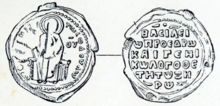

The logothetes tou genikou (Greek: λογοθέτης τοῦ γενικοῦ, often called genikos logothetes or simply ho genikos (ὁ γενικός [λογοθέτης], 'the general [logothete]'), and usually rendered in English as the General Logothete, was in charge of the 'general financial ministry', the genikon logothesion of the middle Byzantine Empire.[1]

The genikon was responsible for general taxation and revenue, and also served as a court for financial cases.[1] As such, it broadly fulfilled the tasks of the earlier sacrae largitiones, although it was mostly derived from the "general department" of the praetorian prefecture.[2] The first attested logothetes tou genikou, the monk Theodotos, is mentioned in 692, but the post may have been instituted as early as 626.[3][1] The bureau of the genikon and its logothete remained one of the chief ministries for the entire middle Byzantine period (7th–12th centuries). During the Komnenian period, its importance declined, but recovered under the Angeloi. Following the sack of Constantinople in 1204 and the dissolution of the Byzantine Empire, the office of the logothetes tou genikou was retained as a purely honorary title by the successor state of Nicaea and the restored Palaiologan Empire after 1261.[1]
The mid-14th century writer Pseudo-Kodinos records him in the 20th place in the imperial hierarchy, between the parakoimomenos of the imperial bedchamber and the protovestiarites.[4] His distinctive court dress and insignia during this time were a brimmed hat called skiadion of white silk, a silk long kaftan-like kabbadion, and for ceremonies and festivities, a domed skaranikon hat of white and gold silk, with gold-wire embroidery and decorated with images of the emperor in the front and back. Unlike other officials, he bore no staff of office (dikanikion).[5] Amongst the Palaiologan-era holders were significant intellectuals and statesmen, such as George Akropolites and Theodore Metochites. The last recorded logothetes tou genikou was a certain John Androuses in 1380.[1] By that time, however, its original functions had long been forgotten; as the Pseudo-Kodinos records, "the function of the General Logothete is unknown".[6]
The subordinates of the logothetēs tou genikou were:
|
Byzantine Empire topics
| |||||||||||||||||||||||||||
|---|---|---|---|---|---|---|---|---|---|---|---|---|---|---|---|---|---|---|---|---|---|---|---|---|---|---|---|
| |||||||||||||||||||||||||||
| |||||||||||||||||||||||||||
| |||||||||||||||||||||||||||
| |||||||||||||||||||||||||||
| |||||||||||||||||||||||||||
| |||||||||||||||||||||||||||
|
| |||||||||||||||||||||||||||